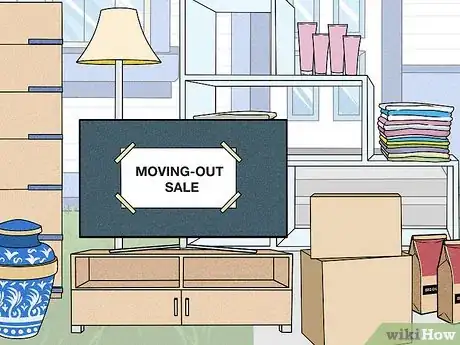This article was co-authored by Marty Stevens-Heebner, SMM-C, CPO® and by wikiHow staff writer, Hannah Madden. Marty Stevens-Heebner is a Certified Professional Organizer (CPO) and Founder of Clear Home Solutions, a home organizing and senior moving management company based in southern California. Marty is the first Certified Senior Move Manager (SMM-C) in the United States and is a Certified Aging in Place Specialist (CAPS) through the National Association of Home Builders. She is the President-Elect and is on the board of directors of the National Association for Senior Move Managers, a member of the National Association of Professional Organizers, and has been acknowledged as a Hoarding Specialist and ADHD Specialist through the Institute for Challenging Disorganization.
There are 10 references cited in this article, which can be found at the bottom of the page.
This article has been viewed 9,574 times.
Moving away from your home can be stressful, but it doesn’t have to be! By cutting costs and saving money, you can focus on making your new place feel like home. Read through some common questions to figure out how you can pack up and move far away without breaking the bank.
Steps
What’s the cheapest way to move out of state?
-
1Renting a truck is usually the cheapest. Hiring a full-service moving team might save you time, but it can really drive up the cost of your move. If you’re looking to cut costs, rent a truck and load it up yourself. You can often find rental trucks for as cheap as $30 to $50 per day. Keep in mind that you will most likely have to fill up your gas tank when you turn the truck back in, and you may have to pay a fee per mile as well.[2]
- If you’re moving out of state, rent a truck from a national company so you can return it when you get to your destination. Local trucks might be cheaper, but they’re probably harder to return when you’re done with them.
- An official moving company can provide insurance in case any of your belongings break while they're being moved.[3]
-
2Getting rid of clutter can also help. As you pack up, try to let go of things you don’t need, like old papers, worn-out clothing, and large furniture. The more you can either sell or donate now, the less you’ll have to pack up in a moving truck to take with you.[4]
What should you not move long distance?
-
1Hazardous items. Chemicals and pesticides don’t need to be moved from your old home to your new one. If you’re cleaning out your garage or your tools and you find opened bottles of chemicals, contact your county to figure out how to get rid of them. Traveling with open chemical containers can be dangerous, so you should try to get rid of them before you set out on your move.[5]
-
2Anything perishable. Frozen food, plants, and produce won’t fare well in a hot moving truck. Get rid of anything that might rot after a few days in the car, especially if it might start to smell. If you have some food you want to take with you, get a small cooler and keep it in the cab of the truck so it’s easily accessible.[6]
-
3Bulky items if you can avoid them. Boxes of books, CDs, DVDs, picture frames, and anything that’s hard to pack neatly is going to take up a lot of space. If you can, try to get rid of some of your bulky items by either donating them or having a garage sale to make some quick cash.[7]
References
- ↑ https://www.homeadvisor.com/cost/storage-and-organization/long-distance-move/
- ↑ https://www.reviews.org/moving/cheapest-way-to-move/
- ↑ Marty Stevens-Heebner, SMM-C, CPO®. Certified Professional Organizer & Senior Move Manager. Expert Interview. 14 January 2020.
- ↑ https://www.homeadvisor.com/cost/storage-and-organization/long-distance-move/#long
- ↑ https://nasdonline.org/1436/d001236/disposal-of-hazardous-household-waste.html
- ↑ https://www.moving.com/tips/what-to-do-with-all-of-your-food-before-moving/
- ↑ https://www.homeadvisor.com/cost/storage-and-organization/long-distance-move/
- ↑ https://www.lifestorage.com/blog/moving/is-it-cheaper-to-ship-furniture-or-buy-new/
- ↑ https://www.movebuddha.com/blog/pods-vs-moving-truck-rental/






























































